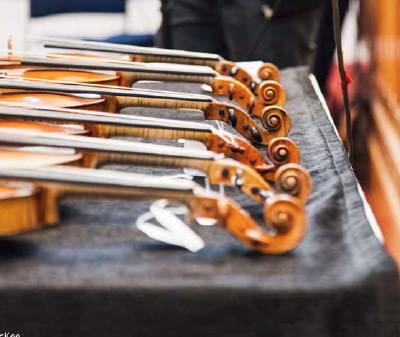Notable Sales: Giovanni Grancino
There is some confusion regarding the early members of the Grancino family, and for many years it was believed that Giovanni, the principal maker of the family, was the son of Paolo Grancino, who was reputed to have been a pupil of Nicolò Amati. No evidence has been found to support Paolo’s existence, and the first known reliable reference to the Grancino family as violin makers comes from Cozio di Salabue, who simply refers to the similarity of the Grancinos’ f-holes to those of Nicolò Amati. Giovanni’s godfather, the composer Michelangelo Grancini, may have been responsible for Giovanni’s choice of career, and in the early years Giovanni worked with his brother Francesco (see the 1692 viola by Giovanni & Francesco Grancino).
Grancino’s instruments were generally made with less spectacular wood than those of his Cremonese competitors, reflecting the requirements of his Milanese clientele, but Grancino was a fine craftsman, as is illustrated by the beautiful f-holes and deeply-cut scroll of the circa 1700 violin. His early instruments have a soft red-brown varnish (see the 1693 violin) but around 1700 this changes to a harder golden yellow. Most of Grancino’s cellos, which were made on the large pattern prevalent in the late 17th century, have been cut down, but an our archive features an uncut example from circa 1695.
In 1708 Grancino was convicted of the manslaughter of his rival Santino Lavazza. He was banished from his hometown and at this point it becomes difficult to keep track of his violin-making activities. The establishment of a shop in the names of his sons Michel Angelo and Francesco may well have been a ruse to allow Giovanni to continue his work, and original labels dated as late as 1726 are known to exist. The date of Grancino’s death has not yet been established with any degree of certainty.
(Milan, b 1637; d 1709)
There is some confusion regarding the early members of the Grancino family, and for many years it was believed that Giovanni, the principal maker of the family, was the son of Paolo Grancino, who was reputed to have been a pupil of Nicolò Amati. No evidence has been found to support Paolo’s existence, and the first known reliable reference to the Grancino family as violin makers comes from Cozio di Salabue, who simply refers to the similarity of the Grancinos’ f-holes to those of Nicolò Amati. Giovanni’s godfather, the composer Michelangelo Grancini, may have been responsible for Giovanni’s choice of... Read more
20 January 2023 - Dilworth, John
From Cremona, the Rosenberg collection takes us to Milan. Evidently the Milanese makers must have been of particular fascination to Rosenberg himself. His collection celebrates the Lombardy capital as intensively and comprehensively as it does Cremona. It begins with an... Read more
19 April 2021 - Dilworth, John
The Evolution of Violin Making from 16th-20th Century Part IV
04 October 2018 - Dilworth, John
The Grancino family, the greatest makers of the classical Milanese school, remain intriguingly mysterious in many ways. As the capital of the Lombardy region, encompassing nearby Cremona, Milan would have had no difficulty in procuring fine instruments from the Amatis... Read more
05 August 2015
You recently borrowed a G.B. Ceruti (1801) and a Giovanni Grancino (1685) violin from us to use in a recording session. How did the two instruments compare? I was recording several commercial tracks for We Write Music Ltd, for different... Read more
We offer buyers and sellers a bespoke private sale service, sourcing exceptional instruments and bows and matching them with the most discerning buyers.
More InformationTim Ingles and Paul Hayday will offer an initial evaluation of the authenticity and value of your instrument or bow to recommend an auction estimate and reserve price.
Enquire
Tim Ingles and Paul Hayday will offer an initial evaluation of the authenticity and value of your instrument or bow. At this stage, the assessment is free and without obligation. In the first instance, we suggest submitting good-quality images to us, preferably by email to info@ingleshayday.com or by completing the valuation form.
Read more